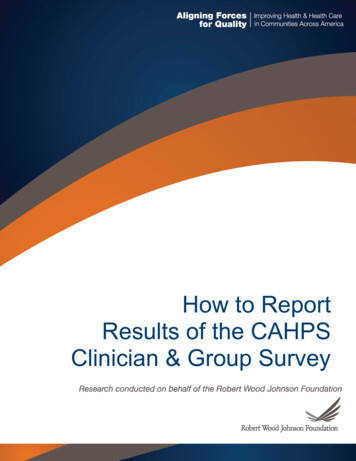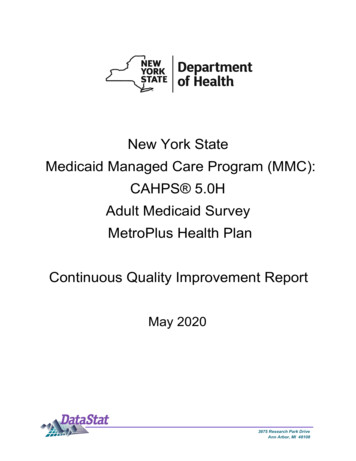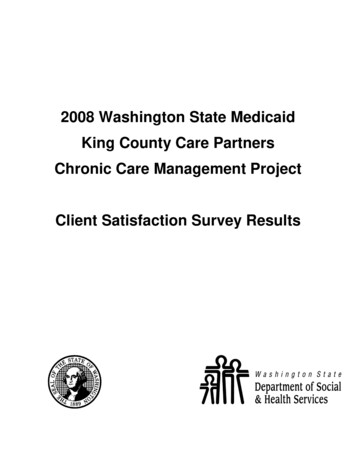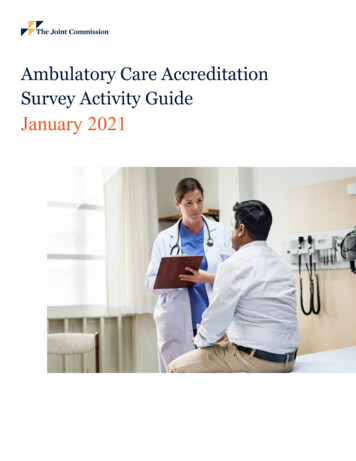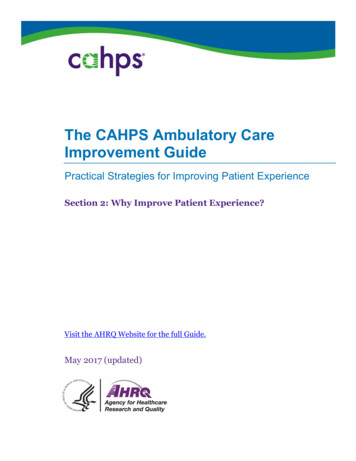
Transcription
The CAHPS Ambulatory CareImprovement GuidePractical Strategies for Improving Patient ExperienceSection 2: Why Improve Patient Experience?Visit the AHRQ Website for the full Guide.May 2017 (updated)
Table of Contents2. WHY IMPROVE PATIENT EXPERIENCE?2-12.A. Forces Driving the Need to Improve. 2-12.B. The Clinical Case for Improving Patient Experience. 2-32.C. The Business Case for Improving Patient Experience. 2-4Overview of the CAHPS Ambulatory Care Improvement GuideThe CAHPS Ambulatory Care Improvement Guide is a comprehensive resource forhealth plans, medical groups, and other providers seeking to improve their performancein the domains of quality measured by CAHPS surveys. Use this guide to help yourorganization: Cultivate an environment that encourages and sustains quality improvement; Analyze the results of CAHPS surveys to identify strengths and weaknesses; and Develop strategies for improving performance.The Guide includes the following sections:1. About the CAHPS Ambulatory Care Improvement Guide2. Why Improve Patient Experience?3. Are You Ready to Improve?4. Ways to Approach the Quality Improvement Process5. Determining Where to Focus Efforts to Improve Patient Experience6. Strategies for Improving Patient Experience with Ambulatory Care
The CAHPS Ambulatory Care Improvement Guide2. Why Improve Patient Experience?2. WHY IMPROVE PATIENT EXPERIENCE?In the face of multiple priorities and limited resources, leaders of health careorganizations may question the value of measuring and improving the patient’sexperience with care. Yet, powerful market and regulatory trends, combined withincreasing evidence linking patient experience to important clinical and businessoutcomes, make a compelling case for improving patient experience as measured byCAHPS surveys.2.A. Forces Driving the Need to ImproveForces contributing to the growing imperative to improve patient experience include thepublic reporting of CAHPS survey scores as well as various initiatives to build measuresof the patient experience into performance-based compensation systems, boardcertification and licensing, and practice recognition programs. A growing demand amongpatients for an enhanced service experience and greater participation in their health careis placing further pressure on health care systems to find ways to become more patientcentered.Examples of prominent forces driving improvement efforts among health plansinclude the following:May 2017 The Centers for Medicare & Medicaid Services (CMS) has been using severalversions of the CAHPS Health Plan Survey since 1998 to measure the experiencesof Medicare beneficiaries. These surveys are conducted annually with resultsreported publicly on the Medicare Plan Finder Web site. CAHPS survey resultsare combined with other quality measures in “star ratings” that take into accountnot only current levels of performance but also progress on improvement. The CAHPS Health Plan Survey is a mandatory part of health plan accreditationrequired by the National Committee for Quality Assurance (NCQA) for bothcommercial and Medicaid health plan product lines. A large number of States require the collection and reporting of the Medicaidversion of the CAHPS Health Plan Survey as part of performance-based managedcare contracts for Medicaid and Children's Health Insurance Program (CHIP)enrollees. Health plans offered in the new Federal and State-based Health InsuranceMarketplaces conduct the Qualified Health Plan (QHP) Survey, which is a versionof the CAHPS Health Plan Survey. Results of the survey will be incorporated intothe “star ratings” for QHPs and may be publicly reported on Marketplace Websites.2-1
The CAHPS Ambulatory Care Improvement Guide2. Why Improve Patient Experience?Examples of forces driving improvement efforts among medical groups andphysician practices include the following: May 2017The Patient Protection and Affordable Care Act of 2010 includes several newprovisions for measuring and reporting patient experience of care:oHealth systems choosing to participate in the Medicare Shared SavingsProgram are required to use the CAHPS Survey for Accountable CareOrganizations (ACOs). The results of the ACO CAHPS Survey (whichbuilds upon the CG-CAHPS core survey) are used for public reporting onthe Physician Compare website, as well as for calculating any “sharedsavings” to be earned by participating ACOs.oSimilarly, the Physician Quality Reporting System (PQRS) programadministered by CMS includes a patient experience survey componentusing the CAHPS for PQRS Survey, which also builds upon the CGCAHPS core survey. Requirements for using this survey are being phasedin over time; eventually, all medical practices with two or more eligibleprofessionals will be required to measure and report patient experienceusing the PQRS CAHPS Survey. These survey results are reported on thePhysician Compare Web site and used with other performance measuresto adjust Medicare fee-for-service (FFS) payments to all participatingphysicians.oStarting in 2019, two new physician payment programs—a merit-basedincentive payment system (MIPS) and eligible alternative paymentmodels (APMs)—are likely to include some version of the CG-CAHPSSurvey as part of the quality measurement formula used for payment.These programs were created under the Medicare Access and CHIPReauthorization Act (MACRA). The National Committee for Quality Assurance’s (NCQA) Patient-CenteredMedical Home program includes optional recognition of patient experience.Physician practices seeking recognition are encouraged to use the CAHPSClinician & Group Survey with the Patient-Centered Medical Home Item Set. Virtually all of the sixteen State and community-based multistakeholderorganizations funded under the Robert Wood Johnson Foundation’s AligningForces for Quality (AF4Q) program included the measurement, reporting, andimprovement of patient experience with primary care in their efforts to reformtheir local health care systems. While the AF4Q program concluded in 2015,many of these collaborative organizations are continuing their survey efforts, asare other regional collaboratives participating in the Network for RegionalHealthcare Improvement (NRHI).2-2
The CAHPS Ambulatory Care Improvement Guide2. Why Improve Patient Experience? The American Board of Medical Specialties (ABMS), which oversees theMaintenance of Certification (MOC) process that 24 medical specialties use toconfirm physicians’ qualifications every five years, continues to explore requiringmedical boards to use patient experience measures to assess the communicationskills and professionalism of physicians with direct patient care responsibilities. The National Priorities Partnership has articulated a goal of measuring and usingpatient experience in all care settings. Its Work Group on Patient and FamilyEngagement has specifically identified widespread implementation of the CAHPSClinician & Group Survey in ambulatory settings as a top priority. Health plans (such as Blue Cross Blue Shield of Massachusetts and HealthPlus ofMichigan) and multi-stakeholder organizations (such as California’s IntegratedHealthcare Association) are incorporating patient experience scores into providerpay-for-performance incentives.2.B. The Clinical Case for Improving Patient ExperienceImproving patient experience has an inherent value to patients and families and istherefore an important outcome in its own right. But good patient experience also isassociated with important clinical processes and outcomes. For example: At both the practice and individual provider levels, patient experience positivelycorrelates to processes of care for both prevention and disease management. 1 Forexample, diabetic patients demonstrate greater self-management skills andquality of life when they report positive interactions with their providers. 2 Patients’ experiences with care, particularly communication with providers,correlate with adherence to medical advice and treatment plans. 3, 4, 5, 6 This isespecially true among patients with chronic conditions, where a strongcommitment from patients to work with their providers is essential for achievingpositive results. 7Sequist TD, Schneider EC, Anastario M, et al. Quality monitoring of physicians: Linking patients’ experiences of care toclinical quality and outcomes. J Gen Intern Med 2008;23(11):1784–90.1Greenfield S, Kaplan HS, Ware JE Jr, et al. Patients’ participation in medical care: Effects on blood sugar control andquality of life in diabetes. J Gen Intern Med 1988;3:448-57.23DiMatteo, MR. Enhancing patient adherence to medical recommendations. JAMA 1994;271(1):79-83.DiMatteo MR, Sherbourne CD, Hays RD, et al. Physicians’ characteristics influence patients’ adherence to medicaltreatment: Results from the Medical Outcomes Study. Health Psychol 1993;12(2):93-102.4Safran DG, Taira DA, Rogers WH, et al. Linking primary care performance to outcomes of care. J Fam Pract1998;47(3):213-20.5Zolnierek KB, Dimatteo MR. Physician communication and patient adherence to treatment: A meta-analysis. Med Care2009;47(8):826-834.6Beach MC, Keruly J, Moore RD. Is the quality of the patient-provider relationship associated with better adherence andhealth outcomes for patients with HIV? J Gen Intern Med 2006;21(6):661-5.7May 20172-3
The CAHPS Ambulatory Care Improvement Guide2. Why Improve Patient Experience? Patients with better care experiences often have better health outcomes. 8, 9 Forexample, studies of patients hospitalized for heart attack showed that patientswith more positive reports about their experiences with care had better healthoutcomes a year after discharge. 10, 11Measures of patient experience also can reveal important system problems, such asdelays in returning test results and gaps in communication that may have broadimplications for clinical quality, safety, and efficiency.2.C. The Business Case for Improving Patient ExperiencePatient experience is correlated with key financial indicators, making it good for businessas well as for patients. For example: Good patient experience is associated with lower medical malpractice risk. 12, 13 A2009 study found that for each drop in patient-reported scores along a five-stepscale of “very good” to “very poor,” the likelihood of a provider being named in amalpractice suit increased by 21.7 percent. 14 Efforts to improve patient experience also result in greater employee satisfaction,reducing turnover. Improving the experience of patients and families requiresimproving work processes and systems that enable clinicians and staff to providemore effective care. A focused endeavor to improve patient experience at onehospital resulted in a 4.7 percent reduction in employee turnover. 15S, Kaplan S, Ware JE Jr. Expanding patient involvement in care: effects on patient outcomes. Ann Intern Med1985;102(4):520-8.8 Greenfield9Stewart MA. Effective physician-patient communication and health outcomes: A review. CMAJ 1995;152(9):1423-33.10 Fremont AM, Clearly PD, Hargraves JL, et al. Patient-centered processes of care and long-term outcomes of acutemyocardial infarction. J Gen Intern Med 2001;14:800-8.11 Meterko M, Wright S, Lin H, et al. Mortality among patients with acute myocardial infarction: The influences of patientcentered care and evidence-based medicine. Health Serv Res 2010 Oct;45(5):1188-204.12 Levinson W, Roter DL, Mullooly JP, et al. Physician-patient communication: The relationship with malpractice claimsamong primary care physicians and surgeons. JAMA 1997;277:553-9.13 Hickson GBC, Clayton EW, Entman SS, et al. Obstetricians’ prior malpractice experience and patients’ satisfaction withcare. JAMA 1994;272:1583-7.14 Fullam F, Garman AN, Johnson TJ, et al. The use of patient satisfaction surveys and alternate coding procedures topredict malpractice risk. Med Care 2009 May;47(5):1-7.Rave N, Geyer M, Reeder B, et al. Radical systems change: Innovative strategies to improve patient satisfaction. J AmbulCare Manage 2003;26(2):159-74.15May 20172-4
The CAHPS Ambulatory Care Improvement Guide2. Why Improve Patient Experience? Patients keep or change providers based upon experience. Relationship quality isa major predictor of patient loyalty; one study found patients reporting thepoorest-quality relationships with their physicians were three times more likelyto voluntarily leave the physician’s practice than patients with the highest-qualityrelationships. 16Resources Browne K, Roseman D, Shaller D, et al. Measuring patient experience as a strategyfor improving primary care. Health Aff 2010 May;29(5):921-5. Shaller Consulting Group. Forces driving implementation of the CAHPS Clinician& Group Survey. Washington, DC. Robert Wood Johnson Foundation; April 2012. Anhang Price R, Elliott MN, Zaslavsky AM, et al. Examining the role of patientexperience surveys in measuring health care quality. Med Care Res Rev 2014;71(5)522-54. Doyle C, Lennox L, Bell D. A systematic review of evidence on the links betweenpatient experience and clinical safety and effectiveness. BMJ Open2013;3(1):e001570.Safran DG, Montgomery JE, Chang H, et al. Switching doctors: Predictors of voluntary disenrollment from a primaryphysician’s practice. J Fam Pract 2001;50(2):130-6.16May 20172-5
Michigan) and multi-stakeholder organizations (such as California's Integrated Healthcare Association) are incorporating patient experience scores into provider pay-for-performance incentives. 2.B. The Clinical Case for Improving Patient Experience . Improving patient experience has an inherent value to patients and families and is



